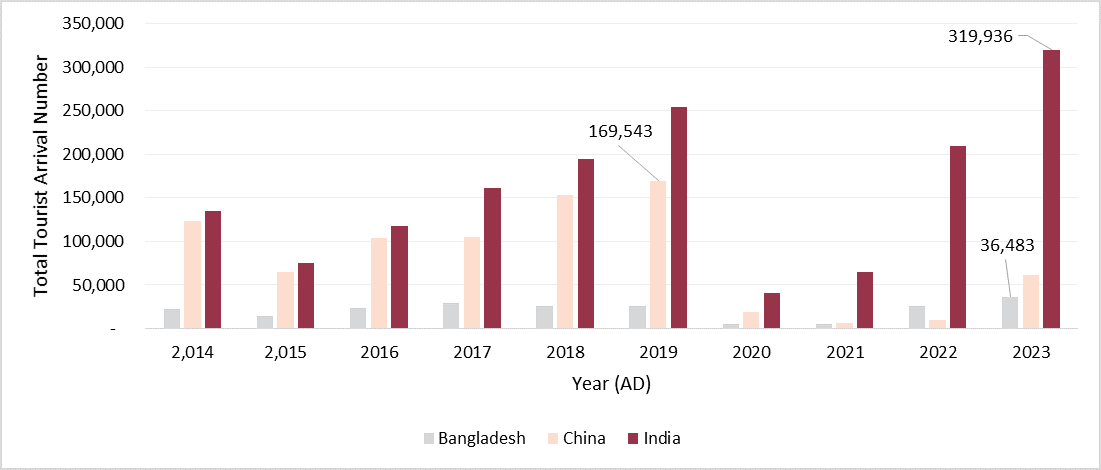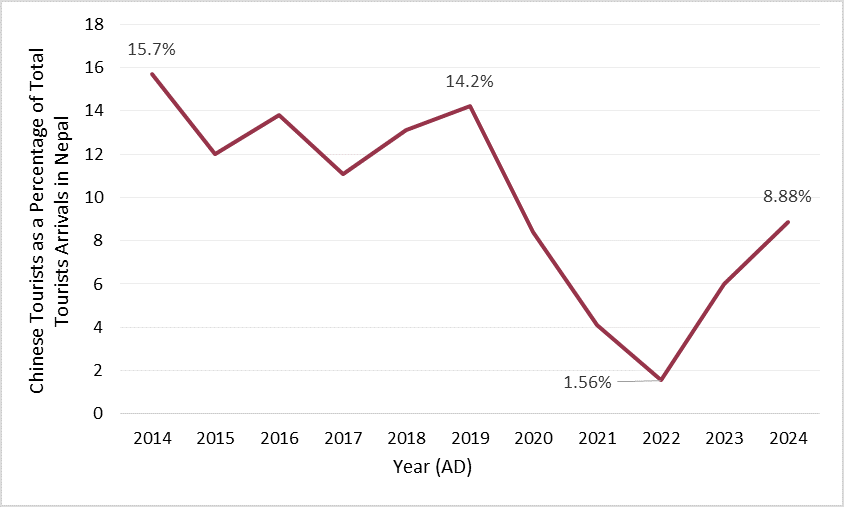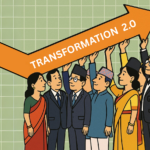Tourism is a key pillar of Nepal’s economy, contributing to foreign exchange, creating jobs, and fueling development across the country. In 2023, Nepal’s tourism sector contributed NPR 327.9 billion to the economy and supported 1.19 million jobs. Within this, regional tourists contribute significantly to Nepal’s visitor base, accounting for about 41.1% of total arrivals in 2023. Among regional markets, India, Bangladesh, and China have consistently ranked among Nepal’s top five source markets for tourism, spurred by proximity and shared cultural ties. In 2023 itself, Indian, Chinese, and Bangladeshi tourists accounted for 31.52%, 5.99%, and 3.59% of total tourist arrivals.
Figure 1. Total Number of Regional Tourists Arriving in Nepal from 2014 to 2023
Source: Nepal Tourism Statistics 2023
While other regional visitors like Indians and Bangladeshis continue to contribute to Nepal’s tourism sector, China presents an important but underutilized opportunity. Over the years, the number of Chinese tourists visiting Nepal have increased, largely driven by their strong interest in Buddhist heritage sites, trekking, and unique cultural experiences. Despite fluctuations in arrival figures, China remains one of Nepal’s key international tourism sources. However, unlocking the full potential of the Chinese market requires a deeper understanding of their travel preferences and behavior.
Understanding Chinese Tourists
Who are the Chinese Tourists in Nepal?
Chinese tourists have played a significant role in Nepal’s tourism industry, with their arrival numbers steadily increasing and reaching a peak of 169,543 in 2019, just prior to the COVID-19 pandemic. Before the pandemic, they were Nepal’s second largest source of international tourists, accounting for 14.2% of total tourist arrivals. Unfortunately, these arrivals were hit hard by the pandemic due to border closures and travel bans resulting from safety concerns. However, with China finally easing their travel bans in 2023, Chinese tourist arrivals have shown a steady recovery, as highlighted in Figure 2. While overall Chinese tourist arrivals of 101,879 tourists in 2024 remains 4.1% below 2019 levels, the trend looks promising with a 13.1% increase in tourist numbers from 2023 to 2024.
Figure 2. Total Proportion of Chinese Tourists from 2014 to 2024
Source: Nepal Tourism Statistics, Nepal Tourism Board
Key Attractions for Chinese Tourists
The primary attraction for Chinese tourists in Nepal has traditionally consisted of Nepal’s cultural, religious, and natural offerings. Destinations like Swayambhunath, Boudhanath, and Kathmandu Durbar Square hold particular appeal for their religious and historical significance along with Lumbini, which is considered an essential location for Buddhist pilgrimage. However, Chinese tourists have now started to explore other facets of tourism as well. Adventure tourism has emerged as a popular choice, with trekking routes such as the Everest Base Camp (EBC) and Annapurna Base Camp (ABC) witnessing a steady influx of Chinese trekkers. This increased interest is reflected in the fact that 198 Chinese tourists applied for trekking permits in 2023. Besides trekking, Chinese tourists have also been displaying growing interest in nature and outdoor activities, including rural and countryside trips.
As per stakeholder consultations, beyond adventure and religious tourism, shopping and dining experiences in Nepal have become increasingly appealing to Chinese tourists. Many visitors enjoy purchasing local handicrafts, jewelry, and cultural artifacts while exploring and trying traditional Nepali cuisine. Additionally, as per various tourism stakeholders, luxury travel from China is also on the rise, with affluent Chinese visitors seeking high-end accommodations. Besides this, a growing number of solo travelers and tourists also choose to drive their own vehicles into Nepal from border points like Kerung, exploring rural areas independently.
Behavioral Patterns and Emerging Trends
Over the years, Chinese tourists’ travel patterns have undergone various changes. Before the pandemic, the rise in the number of Chinese tourists could be attributed to the popularity of the Chinese movie ‘Up in the Wind’, released in 2013. Showcasing Nepal’s cultural landmarks and natural beauty, the film captivated Chinese audiences and resulted in a notable rise in the number of Chinese tourists as many wanted to replicate experiences from the movie and record it through pictures and videos. This cinematic influence significantly boosted Nepal’s visibility in the Chinese market, even leading to some Chinese tourist guidebooks including Pokhara as one of the top 10 places in the world to see before you die.
Meanwhile, more recently, Chinese tourism in Nepal, which was previously dominated by travelling in groups, has shifted towards more independent and flexible travel. Younger Chinese tourists, especially those under 35, increasingly favor personalized travel experiences, mainly due to the convenience of digital platforms for booking and payments. Additionally, social media’s influence has also been an important factor in attracting Chinese tourists, with platforms like TikTok and WeChat playing a central role in their travel planning and decision-making.
Tourism Diplomacy between Nepal and China
The increase in the number of Chinese tourists in Nepal has also led to the two countries taking multiple steps to deepen their touristic and diplomatic ties. An important decision in this regard was when China declared that, beginning on May 1, 2024, Nepalis traveling to mainland China no longer needed to pay visa fees, thereby reciprocating Nepal’s 2016 decision to waive visa fees for Chinese nationals. Similarly, on June 24, 2024, at the 16th ‘Nepal-China Diplomatic Consultation Mechanism’ in Kathmandu, Chinese officials announced that 2025 would be celebrated as the ‘Visit Nepal Year in China’. This marks the first time China has committed to promoting another country’s tourism at a national level. Aligned with Nepal’s ‘Visit Nepal Year 2025’ campaign, the two neighbors are set to collaborate on various events to promote Chinese tourism in Nepal. Besides these measures, on March 19, 2024, Chinese airlines also announced new direct flights to Pokhara and Bhairahawa, aiming to decentralize tourism activities.
However, despite strong diplomatic commitments and promotional efforts, whether or not Nepal will achieve the target of two million Chinese tourists in 2025, as delineated in the Visit Nepal 2025 campaign, remains uncertain. While cultural events and social media campaigns are gaining momentum, a concrete and coordinated strategy is needed. For example, tour operators have emphasized that in order to reach this target, there should be at least 10 daily flights between Nepal and China. This, however, is not the case and is further hindered by the fact that the Tribhuvan International Airport in Kathmandu faces 10-hour daily closures until March 1, thereby complicating connectivity and accessibility.
Outlook
Regional tourism plays a large part in developing the tourism economy in Nepal. Within this, China is increasingly appearing as a major untapped market that could take Nepali tourism to further heights. While the governments of the two countries have taken steps to work on this growing relationship, it is of utmost importance for Nepal to understand the Chinese market and take steps to cater to it. To do so, some possible avenues are launching strategic campaigns, enhancing connectivity, diversifying niche tourism experiences, strengthening digital and payment integration, and streamlining visa processes. Each of these requires further examination to help realize the potential that regional tourism holds. The journey may be demanding, but improving regional tourism can lead to valuable progress not just for the sector, but for the country as a whole.
Anushka Shrestha graduated with a Bachelor's degree in Business Administration (International Hotel Management) from Stamford International University, Thailand. Her interest lies in tourism, hospitality and sustainable businesses. Currently, she works as a Research Fellow at Nepal Economic Forum (NEF). Bibhuti Kharel graduated with a Master's degree in Business Administration (Project Management) from Kathmandu University. She is keen about development economics, diplomacy as well as energy and sustainability. Currently, she works as a Research Fellow at Nepal Economic Forum (NEF), building on her prior experience as a Project Development Intern in the Investment Board of Nepal.





